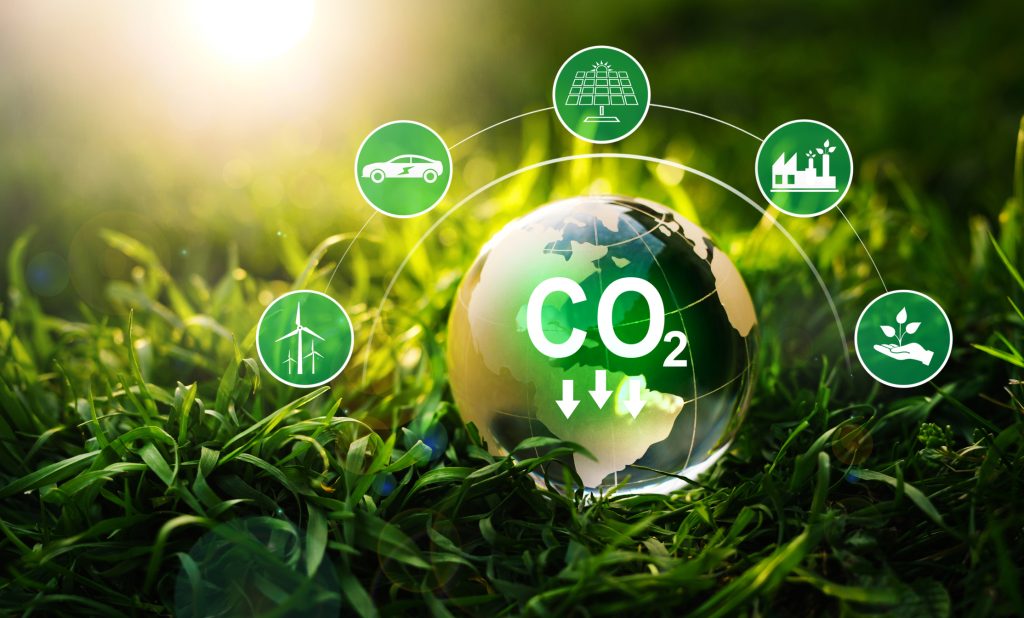Decarbonization: Understanding Its Goals and Impact on Our Future

Sustainable development and green business based on renewable energy. Reduce CO2 emission concept. Renewable energy-based green businesses can limit climate change and global warming
Decarbonization refers to the process of reducing carbon dioxide (CO2) emissions resulting from human activities, particularly those related to energy production and consumption. This crucial environmental strategy is essential for combating climate change and ensuring a sustainable future. As global temperatures continue to rise, the imperative to cut down on greenhouse gas emissions becomes increasingly urgent. Governments, industries, and individuals all play vital roles in this transformation towards a low-carbon economy. Understanding decarbonization, its objectives, and its implications is key to supporting and implementing effective measures to mitigate climate change.
What is Decarbonization?
Decarbonization refers to the process of reducing carbon dioxide (CO2) emissions resulting from human activities, particularly those related to energy production and consumption. This process aims to mitigate climate change by transitioning from fossil fuel-based energy sources to low-carbon or renewable energy sources such as solar, wind, and hydropower. Additionally, decarbonization involves improving energy efficiency in various sectors, such as transportation, industry, and buildings, and adopting technologies that capture and store CO2 emissions. The ultimate goal of decarbonization is to achieve a low-carbon economy, limit global warming, and ensure a sustainable and resilient future for all.
The Concept of Decarbonization
Decarbonisation means reducing the carbon footprint of particular activities, especially by using less fossil fuels and (therefore) using energy more efficiently. The logic here is that the primary cause of global warming and climate change is CO2, so reducing our emissions of it is a primary thing to do. As renewable energy (wind, solar, hydropower and so on) becomes a cheaper and easier option, we can tend to use less of the energy from fossil fuels and thereby cut both the emissions and the environmental damage that goes with fossil energy production. Alternative energy can mean a new economic future as well as a less damaging way of life.
A second key aspect of decarbonisation would be to increase the energy efficiency of all end-use sectors, such as transportation, manufacturing and residential energy use. This would involve using less energy to do the same things, which would reduce the demand for energy and therefore reduce CO2 emissions. Society could do this by developing new technologies, enacting new policies and changing behaviours. For example, switching from internal combustion engine (ICE) cars to electric vehicles (EVs), creating and using more efficient appliances, and adopting smart grid technologies would all involve increasing energy efficiency as part of the larger shift.
Goals of Decarbonization
Decarbonisation follows the clear target of the Paris Agreement, which is to keep global warming ‘well below 2°C above pre-industrial levels’, and ultimately pursue 1.5°C if possible. To reach this target, countries committing to decarbonisation must bring down greenhouse gas emissions, especially of CO2, which is the most abundant greenhouse gas. To set out the specific geographical targets, the strategic plans companies create to reach these goals are called Nationally Determined Contributions (NDCs). These often include increasing the share of renewable electricity, improving energy efficiency, and investing in new technologies.
Third, a low-carbon economy can serve as a basis for greater resilience. As well as reducing emissions, this goal aims to ensure economic growth and development, which are often disrupted by changing climate. Low-carbon investments can bring new opportunities and introduce greater economic and energetic resilience. For instance, innovation in the renewable energy sector is estimated to create millions of jobs worldwide as it continues to grow from a very small base in the coming decades, while the growing manufacturing sector for such technologies can spur economic development even in poor countries. Decarbonisation can also reduce air pollution and thus many human health risks.
Strategies for Decarbonization
Decarbonisation strategies are varied and include a number of technological, policy and behavioural approaches. One key strategy is reducing dependence on fossil fuels in favour of renewable energy sources of solar, wind, hydro and geothermal energy are central to decarbonisation efforts. Governments and the private sector are investing heavily in renewable energy projects, and their use is also increasing due to improving technology and becoming more affordable. Subsidies for renewable energy, combined with implementing a carbon price and renewable energy mandates, can complement technological advancements in renewable energy and help the transition towards it.
Another approach is to improve energy efficiency, which involves reducing energy demand without sacrificing the quality of our lives. For end-use industries, this involves optimising production processes – for instance, using less energy-intensive feedstocks, reducing internal power consumption, improving heat management and using captured industrial emissions for heating or other production processes. Improved energy efficiency can also be achieved through the design and upgrading of buildings and transport infrastructure, and through more intelligent use of key equipment. Good examples include retrofitting buildings with better insulation, replacing incandescent light bulbs with LEDs, applying energy-efficient technologies, and upgrading transport infrastructure for electrification and smart electric grids. Meanwhile, switching to electric vehicles, improving the quality and capacity of public transportation infrastructure, and encouraging more walking, biking and other forms of active transportation can also greatly reduce emissions. Finally, there are technologies that reduce greenhouse gas emissions by capturing carbon dioxide and storing it underground. Examples include carbon capture and storage (CCS), which can be applied to power generation, manufacturing and other industrial processes, as well as direct air capture, which captures CO2 from the atmosphere.
Challenges in Achieving Decarbonization
Despite its clear benefits and the urgency of deep decarbonisation, there are serious challenges to its implementation. The price tag for an absolute transition to renewable energy and energy efficiency improvement is high. Although the subsequent economic benefits might be significant in the long term, the initial costs are not trivial, especially for those poorer countries in the developing world, and their businesses, that struggle to incur such expenses. The existing infrastructure is also based on fossil fuels and the transition to new systems is not just the switch of a light bulb: for some countries this requires significant adjustments in transportation and heating systems, among others.
A second type of barrier relates to political and social impediments to change. Decarbonisation requires policy changes that are often politically unpopular, such as carbon taxes, or the phase-outs of coal plants etc. Some fossil fuel dependent industries (ie, oil and gas) may resist these political changes as they pose risks to short-term profits. From a social perspective, there may also be resistances from communities that are heavily reliant on fossil fuel incomes and employment. Achieving a societal determination to decarbonise requires strong political will, widespread public awareness about the long-term benefits of decarbonisation, and clear communication about the trade-offs in a just transition for all. International support will also be crucial, both financially and in terms of knowledge sharing and technology transfer, particularly for developing countries that are transitioning from fossil fuels.
The Role of Technology in Decarbonization
Technology has a major role to play in decarbonisation, offering novel means of reducing emissions and increasing energy efficiency. Technologies dedicated to producing renewable energy – such as solar panels, wind turbines and hydroelectric power plants – are at the forefront of this endeavour. What’s more, many of these renewable energy technologies have become more efficient, reliable and less costly to operate, helping to make the transition to low-carbon power supply a feasible choice in more and more countries around the world. Energy storage technologies (such as batteries and pumped hydro storage) are equally crucial, as they help to smooth out the intermittent nature of many renewable energy sources and make both the production and consumption of energy much more flexible.
Another important technological development that will drive decarbonisation is the emergence of improved carbon capture and storage (CCS) technologies. CCS consists of capturing the CO2 emissions released by certain industrial processes and power generation plants, and storing them underground to prevent them from being released into the atmosphere. CCS is particularly relevant in industries with hard-to-decarbonise processes, such as cement and steel manufacturing. Likewise, further innovation and investment in energy efficiency technologies, including smart grids, energy-efficient appliances and electric vehicles, will be of paramount importance to reduce final energy consumption and emissions.
The Future of Decarbonization
Carbon neutrality and low-carbon development are the only way forward. Across the world more and more nations are making strong promises to cut their emissions and to switch to renewable energy. With all their promises, global carbon emissions will be definitely reduced. The European Union has a clear long-term vision of becoming the first carbon-neutral continent by 2050. No doubt, other governments will follow the EU fast. Governments’ promises also translate into a huge number of investment in renewable energy and energy-efficiency programming, as well as new technology development intended to, eventually, assist us all to decarbonise and enjoy the same level of life quality as thousands of years ago, or even more.
In the long run, international cooperation will be important in order to realise global decarbonisation goals. Climate change is a global challenge where different countries must work together and share the costs and benefits of carbon reduction efforts. Developed countries should assist developing countries financially, through technology transfer and capacity-building in the decarbonisation effort to make sure that all countries around the globe can contribute and benefit from carbon reduction efforts. As Rifkin argued in his book, climate change is a game of cooperation where no country or continent can successfully tackle carbon reductions alone. Furthermore, substantial investments in innovation and research will continue to be vital to develop new solutions and improve existing technologies. In the end, we must all work together and engage all stakeholders, including governments, the business sector and citizens, in the decarbonisation effort, if we are to build a more resilient and sustainable future in the low-carbon world for our children and grandchildren.
Conclusion
Decarbonization is a critical strategy for mitigating climate change and ensuring a sustainable future. By reducing CO2 emissions through the transition to renewable energy, enhancing energy efficiency, and developing new technologies, we can achieve significant environmental and economic benefits. Despite the challenges, strong political will, public awareness, and international cooperation are key to overcoming obstacles and driving progress. As we look towards the future, continued commitment and innovation will be essential in achieving our decarbonization goals and creating a low-carbon world for future generations.







